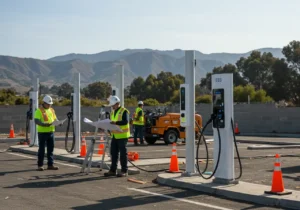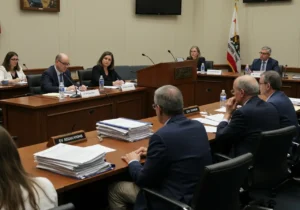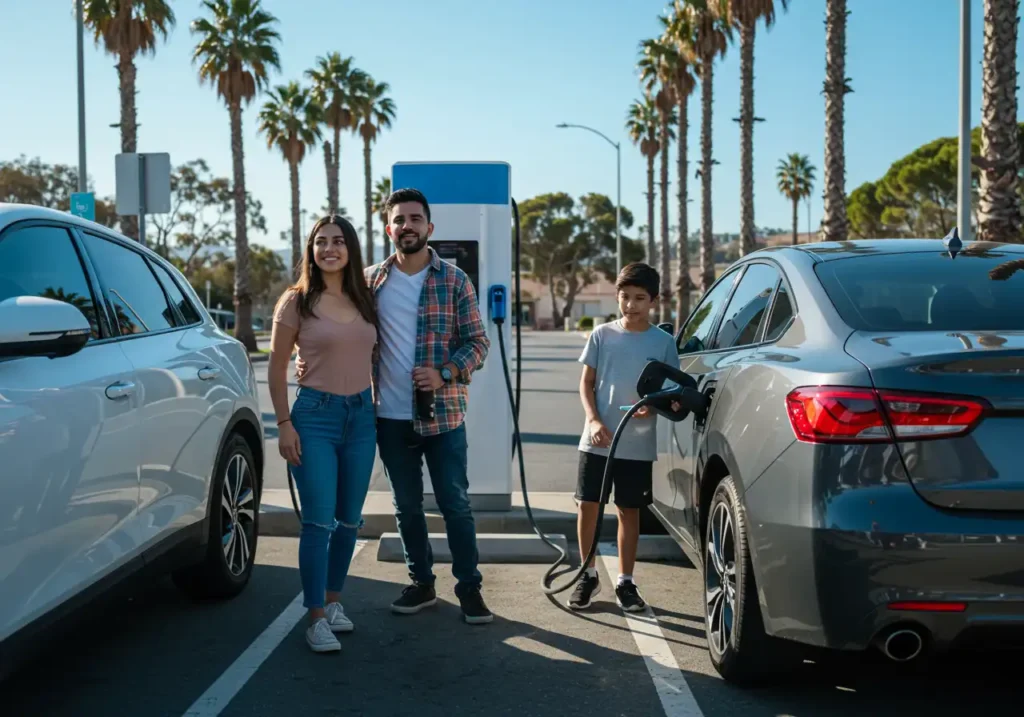Electric vehicles in California are essential for lowering emissions and promoting clean transportation. The state’s dedication to encouraging EV adoption demonstrates its leadership in the battle against climate change. California’s goal is to reduce greenhouse gas emissions, enhance air quality, and establish a sustainable future by shifting to electric vehicles.
This article explores:
- The incentives behind EV adoption
- The obstacles confronting infrastructure and market expansion
- Success stories that highlight progress
- The regulatory framework influencing the future of electric vehicles in California
Incentives of Driving Electric Vehicle Adoption in California
Description of the Driving Clean Assistance Program (DCAP): The Driving Clean Assistance Program (DCAP) plays a crucial role in promoting electric vehicle adoption among underserved and disadvantaged communities in California. Funded by the California Air Resources Board (CARB) and managed by the Community Housing Development Corporation, DCAP offers grants, financial coaching, and incentives specifically aimed at low-income, tribal, and disadvantaged populations. These grants assist in purchasing or leasing new or used battery electric, plug-in hybrid, and fuel cell vehicles.
Role of California Climate Investments
California Climate Investments uses Cap-and-Trade revenue to fund various EV incentives. This initiative is part of a statewide effort to reduce greenhouse gas emissions while improving public health. The program allocates significant resources towards making clean transportation accessible to all Californians, particularly those from lower-income backgrounds.
Federal Incentive Programs
Federal incentive programs support state efforts by providing additional assistance for affordable EV ownership. These programs work alongside California’s initiatives to ensure that lower-income populations can transition to cleaner transportation options without facing high costs.
Encouraging Adoption of Various EV Types
The combination of these incentives encourages the adoption of different types of electric vehicles:
- Battery Electric Vehicles (BEVs): Fully electric cars that run solely on battery power.
- Plug-In Hybrid Vehicles (PHEVs): Vehicles that combine an internal combustion engine with an electric motor and battery.
- Fuel Cell Vehicles (FCVs): Cars powered by hydrogen fuel cells that produce electricity on board.
By addressing financial barriers, these incentives significantly boost the adoption rates of BEVs, PHEVs, and FCVs across diverse demographics in California.
Challenges Facing Electric Vehicle Infrastructure and Market Growth
 California’s roadmap to a zero-emission future hinges on an aggressive buildout of EV charging infrastructure. The state set targets of 1 million public chargers by 2030 and 2.1 million by 2035—numbers that translate to the installation of roughly 129,000 new charging stations every year through the next seven years. This unprecedented pace has never been attempted on such a scale in the U.S., and it exposes several critical EV charging infrastructure challenges.
California’s roadmap to a zero-emission future hinges on an aggressive buildout of EV charging infrastructure. The state set targets of 1 million public chargers by 2030 and 2.1 million by 2035—numbers that translate to the installation of roughly 129,000 new charging stations every year through the next seven years. This unprecedented pace has never been attempted on such a scale in the U.S., and it exposes several critical EV charging infrastructure challenges.
Key Barriers to Charger Deployment:
- High Costs and Investment Needs: Fast chargers typically cost more than $120,000 each to install, factoring in equipment, construction, permitting, and grid upgrades. Meeting California’s public charger goals will require multi-billion-dollar investments from both public and private sectors.
- Permitting Delays & Grid Connection Issues: Many projects face bottlenecks at the local level, where permitting processes can drag for months or even years. Utilities often need lengthy timelines for grid connection approvals, further slowing progress. These grid connection issues for EV chargers can be a major stumbling block for timely deployment.
- Supply Chain Constraints: Shortages in hardware, electrical components, and skilled labor have delayed charger installations statewide. Lead times for key parts routinely stretch out project timelines.
- Market Uncertainty & Investment Hesitancy: Slower-than-projected EV adoption rates mean some investors are cautious about pouring capital into public charging networks. Profitability concerns linger—public chargers are expensive to maintain and aren’t always in high enough demand yet.
- Tesla’s Market Dominance: Tesla leads in fast-charging accessibility with its extensive Supercharger network, raising questions about competition and interoperability as other providers catch up.
- Electrify America’s Growing Pains: As one of the largest non-Tesla networks, Electrify America faces ongoing criticism for reliability issues and inconsistent customer service. The company is working on software upgrades and better uptime metrics, but it remains a work in progress.
The combination of high upfront costs, bureaucratic hurdles, supply chain delays, and market risk creates a challenging environment for scaling public charger installation in California. Addressing these obstacles will determine how quickly the state can reach its ambitious zero-emission vehicle targets and ensure equitable access to reliable charging across all communities.
Success Stories Highlighting Progress in California’s EV Ecosystem
California EV sales leadership stands out across the country. The state consistently leads in both electric vehicle (EV) sales and public charging infrastructure, setting benchmarks that other states strive to match. With about 23% of new car sales classified as zero-emission vehicles (ZEVs) by early 2023, and more than 2.2 million ZEVs registered statewide, California’s adoption rate far surpasses the national average.
Startups Driving Charger Access
Startups have played a vital role in accelerating charger access. Between 2020 and 2024, fast charger startups such as EVgo, ChargePoint, and Blink dramatically expanded their networks. This surge not only made public charging more available but also introduced innovations in payment options, charger reliability, and user experience.
Automaker Collaboration Shaping the Future
A major development shaping the future is the collaboration between automakers to expand public charging infrastructures. Seven leading automakers—including BMW, General Motors, Honda, Hyundai, Kia, Mercedes-Benz, and Stellantis—have committed $1 billion to build a North American network of 30,000 high-speed chargers. This joint venture targets gaps in existing infrastructure and aims for seamless interoperability regardless of vehicle brand.
State Funding as a Key Driver
State funding remains a key driver. Under the “California Climate Commitment,” the state government pledged $1 billion through 2028 exclusively to expand charging infrastructure. These investments focus on both urban hubs and rural corridors to ensure equitable access. Recently, the Biden-Harris administration announced $623 million in grants aimed at further enhancing electric vehicle infrastructure across the state.
The rising market share of ZEVs reflects growing consumer confidence and sustained investment from both public and private sectors. This momentum sets the stage for regulatory shifts shaping EV adoption across California.
Regulatory Context Shaping the Future of Electric Vehicles in California
California’s Zero-Emission Vehicle (ZEV) Mandate
California has set ambitious zero-emission vehicle (ZEV) sales mandates, targeting a complete phaseout of gas-powered cars by 2035. These regulations demand progressively higher percentages of ZEVs among new car sales, aiming for 68% by 2030 and 100% by 2035. This aggressive approach underscores California’s dedication to reducing greenhouse gas emissions and advancing clean transportation technologies.
Clean Air Act Waiver Controversy
The recent U.S. Senate blockage of California’s electric car mandate waiver under the Clean Air Act has introduced significant legal uncertainty. This waiver is crucial for California to enforce its stringent emissions standards independently. The Senate’s decision has sparked a debate on state versus federal authority in setting environmental regulations, impacting the state’s ability to meet its ZEV goals.
Political Debate: Costs, Accessibility, and Consumer Choice
 There is an ongoing political debate surrounding the costs associated with ZEV mandates, charger accessibility, and consumer choice. Critics argue that the financial burden of transitioning to electric vehicles may disproportionately affect lower-income consumers and highlight concerns over the current infrastructure’s readiness to support widespread EV adoption. On the other hand, environmental advocates emphasize the long-term benefits, including reduced air pollution and public health improvements.
There is an ongoing political debate surrounding the costs associated with ZEV mandates, charger accessibility, and consumer choice. Critics argue that the financial burden of transitioning to electric vehicles may disproportionately affect lower-income consumers and highlight concerns over the current infrastructure’s readiness to support widespread EV adoption. On the other hand, environmental advocates emphasize the long-term benefits, including reduced air pollution and public health improvements.
Impact on Automakers, Consumers, and Infrastructure Planning
Regulatory developments significantly impact automakers, consumers, and infrastructure planning. For automakers, meeting California’s ZEV mandates requires substantial investments in new technologies and manufacturing processes. Consumers face decisions influenced by the availability, affordability, and convenience of charging infrastructure. Infrastructure planning must accommodate the rapid expansion and integration of EV chargers to ensure seamless adoption.
Understanding these regulatory dynamics is essential for stakeholders navigating California’s evolving EV landscape. The interplay between state ambitions and federal responses will shape the future trajectory of electric vehicle adoption in this pioneering state.
Conclusion
The future of EVs in California depends on unwavering collaboration between state agencies, automakers, utilities, local governments, and community organizations. When each stakeholder plays an active role—removing infrastructure barriers, designing inclusive incentive programs, accelerating permitting, and prioritizing underserved communities—the path to a clean energy transition becomes clearer.
This blog illustrates that persistent and collective action transforms clean transportation from an ambitious goal into a practical reality. Stakeholders who work together can overcome even the toughest clean energy transition challenges—setting a model for states nationwide.

